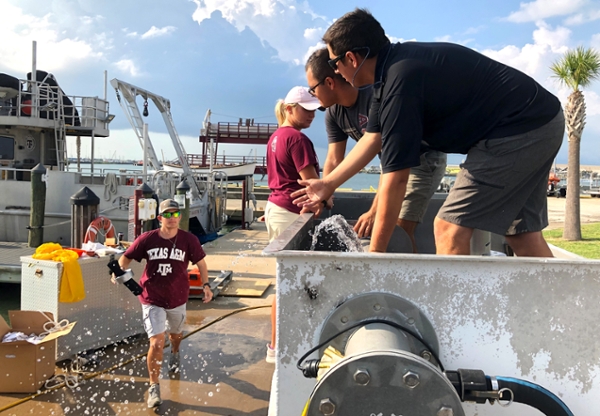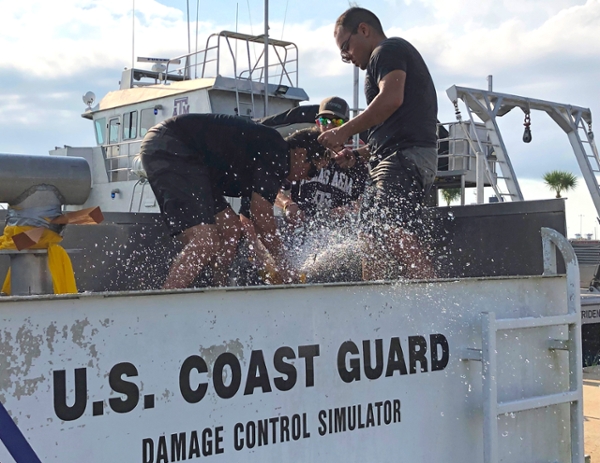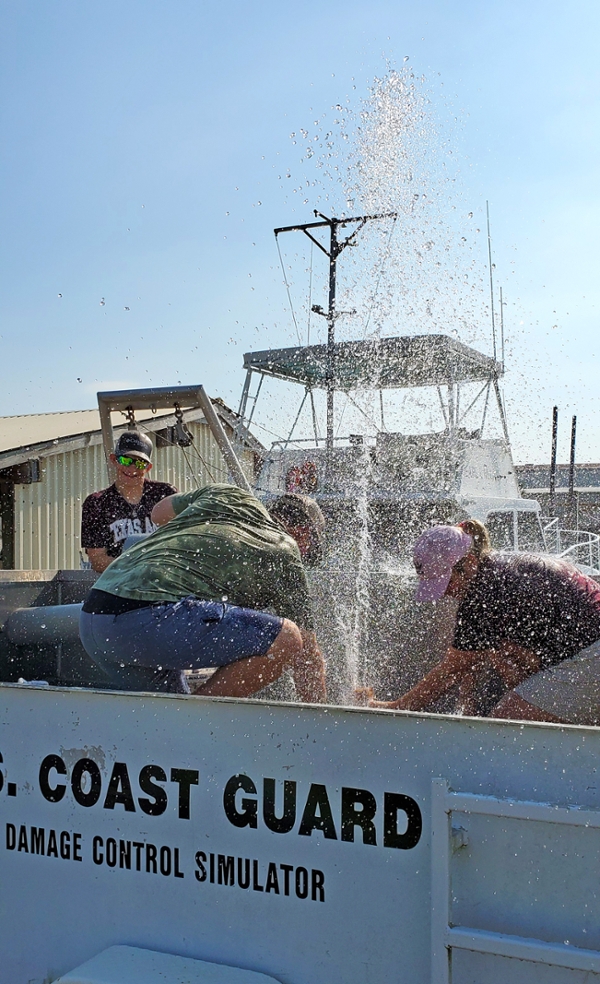Rubber, Rope, Training & Hope: Texas A&M University at Galveston’s Vessel Operations Crew Utilizes Damage Control Simulator for Emergency Training
September 13, 2019
Tweet
A MESSO and vessel operations staff member runs to his other team members bearing rubber and duct tape to help stem a leak during training drills on the U.S. Coast Guard’s damage control simulator Friday morning.
By Andréa Bolt, Marketing and Communications
Texas A&M University at Galveston’s Marine Education Support & Safety Operations (MESSO) staff and vessel operations crew got their feet wet undergoing crucial training via the U.S. Coast Guard’s Marine Safety Unit - Texas City (MSU) and the Commercial Fishing Vessel Safety team with their hands-on damage control simulator early this morning.
MESSO’s Captain Jason Brunson contacted Todd Whitecotton and Wally Cutchins of the MSU-Texas City office to bring the towable container to campus for staff to test their flood and leak mitigation skills. The damage control trainer provides the opportunity for practice with various types of flooding scenarios one might encounter on fishing boats or vessels like the R/V Trident, R/V Earl L. Milan and more.
“If a pipe breaks, this teaches us how to seal the leak with parts we have on the boat and in our damage control kit,” said Capt. Brunson. “Anything from wood wedges to rope, a wetsuit, even rain gear or rags - just things we have available on a boat, this will help us to be as prepared as possible in situations like this. We all know the sea can be unpredictable.”
Groups of two and three crew members stood inside the open container while Cutchins called out varying scenarios of leaks and where the crew would be located aboard the vessel while Whitecotton opened various valves, shooting water into the sky. Crews had to handle multiple leaks and also decide which to address, monitor ongoing bursts and work as quickly as possible utilizing whatever materials they had on hand, be it duct tape, rope, rain gear or rubber, to assess and contain the leak as best as possible.
Cutchins emphasized the importance of communication during the exercise and crew members responded accordingly, detailing the intensity of the leak, announcing what knots they be would tying if using rope and how high the water level was in the makeshift vessel.
“This is real-life stuff,” Cutchins explained. He told the group how he and a crew experienced a shrimping vessel that recently overturned in the Baytown area and how one person aboard the vessel passed away while another was trapped in the engine room and found herself doused in gasoline, but survived the ordeal. “These are skills everyone here should have. You also have to know how to control your adrenaline when that kicks in. You just have to know how to handle yourself and keep everyone as calm as possible in a situation like this so you can all know when to abandon ship or have the best-case scenario.”
Capt. Brunson said he intends to bring the damage control simulator to campus bi-annually for increased future training opportunities.

MESSO and vessel operations staff and crew members work together to plug a simulated pipe burst leak during training drills on the U.S. Coast Guard’s damage control simulator Friday morning.

Water sprays high into the air Friday morning as MESSO and vessel operations staff and crew members work to stop a simulated leak during training drills on the U.S. Coast Guard’s damage control simulator.
###
More:
Marine Engineering Technology
Maritime Transportation
Texas A&M Maritime Academy
Student Life